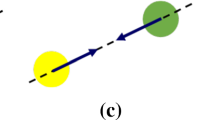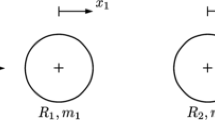Abstract
This paper presents a unifying dynamics formulation for nonsmooth multibody systems (MBSs) subject to changing topology and multiple impacts based on a linear projection operator. An oblique projection matrix ubiquitously yields all characteristic variables of such systems as follows: (i) the constrained acceleration before jump discontinuity from the projection of unconstrained acceleration, (ii) post-impact velocity from the projection of pre-impact velocity, (iii) impulse during impact from the projection of pre-impact momentum, (iv) generalized constraint force from the projection of generalized input force, and (v) post-impact kinetic energy from pre-impact kinetic energy based on projected inertia matrix. All solutions are presented in closed-form with elegant geometrical interpretations. The formulation is general enough to be applicable to MBSs subject to simultaneous multiple impacts with nonidentical restitution coefficients, changing topology, i.e., unilateral constraints becoming inactive or vice versa, or even when the overall constraint Jacobian becomes singular. Not only do the solutions always exist regardless of the constraint condition, but also the condition number for a generalized constraint inertia matrix is minimized in order to reduce numerical sensitivity in computation of the projection matrix to roundoff errors. The model is proven to be energetically consistent if a global restitution coefficient is assumed. In the case of nonidentical restitution coefficients, the set of energetically consistent restitution matrices is characterized by using a linear matrix inequality (LMI).




Similar content being viewed by others
References
McClamroch, N.H., Wang, D.: Feedback stabilization and tracking in constrained robots. IEEE Trans. Autom. Control 33, 419–426 (1988)
Garcia de Jalón, J., Bayo, E.: Kinematic and Dynamic Simulation of Multibody Systems: The Real-Time Challenge. Springer, New York (1994)
Blajer, W., Schiehlen, W., Schirm, W.: A projective criterion to the coordinate partitioning method for multibody dynamics. Appl. Mech. 64, 86–98 (1994)
Aghili, F.: Control of redundant mechanical systems under equality and inequality constraints on both input and constraint forces. J. Comput. Nonlinear Dyn. 6(3), 031013 (2011)
Aghili, F., Su, C.: Impact dynamics in robotic and mechatronic systems. In: 2017 International Conference on Advanced Mechatronic Systems (ICAMechS), pp. 163–167 (2017)
Gottschlich, S.N., Kak, A.C.: A dynamic approach to high-precision parts mating. IEEE Trans. Syst. Man Cybern. 19(4), 797–810 (1989)
Dupree, K., Liang, C.H., Hu, G., Dixon, W.E.: Adaptive Lyapunov-based control of a robot and mass–spring system undergoing an impact collision. IEEE Trans. Syst. Man Cybern., Part B, Cybern. 38(4), 1050–1061 (2008)
Marhefka, D.W., Orin, D.E.: A compliant contact model with nonlinear damping for simulation of robotic systems. IEEE Trans. Syst. Man Cybern., Part A, Syst. Hum. 29(6), 566–572 (1999)
Khulief, Y.A.: Modeling of impact in multibody systems: an overview. J. Comput. Nonlinear Dyn. 8(2), 021012 (2013)
Brogliato, B.: Kinetic quasi-velocities in unilaterally constrained Lagrangian mechanics with impacts and friction. Multibody Syst. Dyn. 32(2), 175–216 (2014)
Hunt, K.H., Crossley, F.R.E.: Coefficient of restitution interpreted as damping in vibroimpact. J. Appl. Mech. 42, 440–445 (1975)
Goldsmith, W.: Impact: The Theory and Physical Behavior of Colliding Solids. Edward Arnold, London (1960)
Lankarani, H.M., Nikravesh, P.E.: A contact force model with hysteresis damping for impact analysis of multibody systems. J. Mech. Des. 112, 369–376 (1990)
Hurmuzlu, Y., Chang, T.H.: Rigid body collisions of a special class of planar kinematic chains. IEEE Trans. Syst. Man Cybern. 22(5), 964–971 (1992)
Mu, X., Wu, Q.: On impact dynamics and contact events for biped robots via impact effects. IEEE Trans. Syst. Man Cybern., Part B, Cybern. 36(6), 1364–1372 (2006)
Liu, C., Zhao, Z., Brogliato, B.: Frictionless multiple impacts in multibody systems. I. Theoretical framework. Proc. R. Soc. A 464, 3193–3211 (2008)
Zhao, Z., Liu, C., Brogliato, B.: Planar dynamics of a rigid body system with frictional impacts. II. Qualitative analysis and numerical simulations. Proc. R. Soc. A 465, 2267–2292 (2009)
Yoshida, Y., Takeuchi, K., Miyamoto, Y., Sato, D., Nenchev, D.: Postural balance strategies in response to disturbances in the frontal plane and their implementation with a humanoid robot. IEEE Trans. Syst. Man Cybern. Syst. 44(6), 692–704 (2014)
Schiehlen, W., Seifried, R., Eberhard, P.: Elastoplastic phenomena in multibody impact dynamics. Comput. Methods Appl. Mech. Eng. 195, 6874–6890 (2006)
Zhang, X., Vu-Quoc, L.: Modeling the dependence of the coefficient of restitution on the impact velocity in elasto-plastic collisions. Int. J. Impact Eng. 27(3), 317–341 (2002)
Najafabadi, S.M., Kovecses, J., Angeles, J.: Impacts in multibody systems: modeling and experiments. Multibody Syst. Dyn. 120, 163–176 (2008)
Pena, F., Lourenco, P.B., Campos-Costa, A.: Experimental dynamic behavior of free-standing multi-block structures under seismic loadings. J. Earthq. Eng. 12(6), 953–979 (2008)
Aghili, F., Buehler, M., Hollerbach, J.M.: Dynamics and control of direct-drive robots with positive joint torque feedback. In: IEEE Int. Conf. Robotics and Automation, vol. 2, pp. 1156–1161 (1997)
Arponen, T.: Regularization of constraint singularities in multibody systems. Multibody Syst. Dyn. 6, 355–375 (2001)
Blajer, W.: Augmented lagrangian formulation: geometrical interpretation and application to systems with singularities and redundancy. Multibody Syst. Dyn. 8, 141–159 (2002)
Aghili, F., Piedbœuf, J.-C.: Simulation of motion of constrained multibody systems based on projection operator. Multibody Syst. Dyn. 10, 3–16 (2003)
Muller, A.: A conservative elimination procedure for permanently redundant closure constraints in MBS models with relative coordinates. Multibody Syst. Dyn. 16, 309–330 (2006)
Aghili, F.: A unified approach for inverse and direct dynamics of constrained multibody systems based on linear projection operator: applications to control and simulation. IEEE Trans. Robot. 21(5), 834–849 (2005)
Mistry, M., Buchli, J., Schaal, S.: Inverse dynamics control of floating base systems using orthogonal decomposition. In: 2010 IEEE International Conference on Robotics and Automation (ICRA), pp. 3406–3412 (2010)
Mistry, M., Righetti, L.: Operational space control of constrained and underactuated systems. In: Proceedings of Robotics: Science and Systems, Los Angeles, CA, USA (2011)
Righetti, L., Buchli, J., Mistry, M., Schaal, S.: Inverse dynamics control of floating-base robots with external constraints: a unified view. In: 2011 IEEE International Conference on Robotics and Automation (ICRA), pp. 1085–1090 (2011)
Ahmad, M., Ismail, K.A., Mat, F.: Impact models and coefficient of restitution: a review. J. Eng. Appl. Sci. 11(10), 6549–6555 (2016)
Ismail, K.A., Stronge, W.: Impact of viscoplastic bodies: dissipation and restitution. J. Appl. Mech. 75(6), 061011 (2008)
Kangur, K., Kleis, I.: Experimental and theoretical determination of the coefficient of velocity restitution upon impact. Mech. Solids 23(5), 2–5 (1988)
Jackson, R.L., Green, I., Marghitu, D.B.: Predicting the coefficient of restitution of impacting elastic-perfectly plastic spheres. Nonlinear Dyn. 60(3), 217–229 (2010)
Stronge, W.: Unraveling paradoxical theories for rigid body collisions. J. Appl. Mech. 58, 1049–1055 (1991)
Stoianovici, D., Hurmuzlu, Y.: A critical study of the applicability of rigid-body collision theory. J. Appl. Mech. 63(2), 307–316 (1996)
Lu, C.J., Kuo, M.C.: Coefficients of restitution based on a fractal surface model. J. Appl. Mech. 70(3), 339–345 (2003)
amd, J.G.V., Braatz, R.D.: A tutorial on linear and bilinear matrix inequalities. J. Process Control 10, 363–385 (2000)
Gahinet, P., Nemirovski, A., Laub, A.J., Chilali, M.: The LMI control toolbox. In: Proceedings of the 3rd European Control Conference, Rome, Italy, 1995, pp. 3206–3211 (1995)
Delebecque, R.N.F., Ghaoui, L.E.: LMITOOL: A Package for LMI Optimization in Scilab—User’s Guide (1995)
Golub, G.H., Loan, C.F.V.: Matrix Computations. Johns Hopkins University Press, Baltimore (1996)
Aghili, F.: Non-minimal order model of mechanical systems with redundant constraints for simulations and controls. IEEE Trans. Autom. Control 61(5), 1350–1355 (2016)
Author information
Authors and Affiliations
Corresponding author
Additional information
Publisher’s Note
Springer Nature remains neutral with regard to jurisdictional claims in published maps and institutional affiliations.
Publisher’s Note
Springer Nature remains neutral with regard to jurisdictional claims in published maps and institutional affiliations.
Appendices
Appendix A: Time-derivative of a projection matrix
The Tikhonov regularization theorem [42] describes the pseudo-inverse as the following limit:
By differentiation of the above expression, one can verify that the time-derivative of the pseudo-inverse can be written in the following form:
On the other hand, using (58) in the time-derivative of the expression of the projection matrix \(\boldsymbol{P}= \boldsymbol{I} - \boldsymbol{A}^{+} \boldsymbol{A}\) yields
where \(\boldsymbol{\varLambda }=- \boldsymbol{A}^{+} \dot{\boldsymbol{A}} \boldsymbol{P}\). Note that identity \(\boldsymbol{P} \boldsymbol{A}^{+} = \boldsymbol{A}^{+T} \boldsymbol{P} = \boldsymbol{0}\) implies \(\boldsymbol{\varLambda }^{T} \boldsymbol{P} = \boldsymbol{0}\) and hence one can conclude \(\ddot{\boldsymbol{q}}_{\perp }= \dot{\boldsymbol{P}} \dot{\boldsymbol{q}}= \boldsymbol{\varLambda } \dot{\boldsymbol{q}} = \boldsymbol{\varOmega }\dot{\boldsymbol{q}}\) [43].
Appendix B: Properties of \(\boldsymbol{M}_{c}\)
Consider a nonzero vector \(\boldsymbol{a} \in \mathbb{R}^{n}\) and its orthogonal decomposition components \(\boldsymbol{a}_{\parallel }=\boldsymbol{P} \boldsymbol{a}\) and \(\boldsymbol{a}_{\perp }=(\boldsymbol{I} - \boldsymbol{P}) \boldsymbol{a}\). Then, one can say that
Notice that both terms \(\boldsymbol{a}^{T}_{\parallel } \boldsymbol{M} \boldsymbol{a}_{\parallel }>0\) and \(\| \boldsymbol{a}_{\perp } \|^{2}>0\) are positive semi-definite. Moreover, for a given nonzero vector \(\boldsymbol{a}\), if \(\boldsymbol{a}_{\perp }= \boldsymbol{0}\) then \(\boldsymbol{a}^{T}_{\parallel } \neq 0\), and vice versa. This means that the sum of the two orthogonal terms must be positive definite, and so must be the constraint inertia matrix \({\boldsymbol{M}}_{c}\).
By definition we have
Since \(\boldsymbol{M}_{c}\) is always invertible, i.e., \(\boldsymbol{M}_{c}^{-1}\boldsymbol{M} _{c} = \boldsymbol{I}\), the above equation can be equivalently written as
which proves (9e).
From definition we have \(\boldsymbol{M}_{c} \boldsymbol{P} = \boldsymbol{M}\), and hence \(\boldsymbol{M} \boldsymbol{M}_{c}^{-1} = \boldsymbol{M}_{c} \boldsymbol{P} \boldsymbol{M}_{c}^{-1} = \boldsymbol{M} _{c} \boldsymbol{M}_{c}^{-1} \boldsymbol{P} = \boldsymbol{P}\), which proves relationship (9d).
Now, consider the characteristic equation of the constraint mass matrix
Clearly, \(\lambda =\nu \) is the eigenvalue for all orthogonal eigenvectors which span \(\mathcal{N}^{\perp }(\boldsymbol{A})\) because \(\lambda =\nu \) means \((\boldsymbol{P} \boldsymbol{M} \boldsymbol{P} - \boldsymbol{P})\boldsymbol{x} =\boldsymbol{0} \quad \forall \boldsymbol{x} \in {\mathcal{N}}^{\perp }(\boldsymbol{A})\). The remaining set of orthogonal eigenvectors must lie in \(\mathcal{N}(\boldsymbol{A})\) that correspond to the nonzero eigenvalues of \(\boldsymbol{P} \boldsymbol{M} \boldsymbol{P}\):
Therefore, the set of all eigenvalues of the positive definite matrix \({\boldsymbol{M}}_{c}\) is the union of the above sets corresponding to the eigenvectors in \(\mathcal{N}\) and \(\mathcal{N}^{\perp }\), i.e.,
where \(\{ \lambda _{\stackrel{\mathrm{min}}{\neq 0}}(\boldsymbol{P} \boldsymbol{M} \boldsymbol{P}), \dots , \lambda _{\mathrm{max}}(\boldsymbol{P} \boldsymbol{M} \boldsymbol{P}) \}\) are all nonzero eigenvalues of \(\boldsymbol{P} \boldsymbol{M} \boldsymbol{P}\). According to (60), the condition number of \(\boldsymbol{M}_{c}\), which is simply the ratio of the largest to smallest eigenvalues, is
Clearly, the RHS of (61) is at its minimum if \(\nu \) is selected to be within the lower- and upper-bounds defined in (9f).
By virtue of (60), the Singular Value Decomposition of \(\boldsymbol{M}_{c}\) takes the form
where matrix \(\boldsymbol{\varSigma }=\mbox{diag}\{ \lambda _{\stackrel{\mathrm{min}}{\neq 0}}(\boldsymbol{P} \boldsymbol{M} \boldsymbol{P}), \dots ,\lambda _{\mathrm{max}}(\boldsymbol{P} \boldsymbol{M} \boldsymbol{P})\}\) contains the nonzero singular values, \(\boldsymbol{V}=[\boldsymbol{V}_{1} \;\; \boldsymbol{V}_{2}]\) is a unitary matrix so that \(\mbox{span}(\boldsymbol{V}_{1}) \equiv {\mathcal{N}} ^{\perp }\) and \(\mbox{span}(\boldsymbol{V}_{2}) \equiv {\mathcal{N}}\), i.e., \(\boldsymbol{P} = \boldsymbol{V}_{2} \boldsymbol{V}_{2}^{T}\), \(\boldsymbol{V}_{2}^{T} \boldsymbol{V}_{2} = \boldsymbol{I}\), and \(\boldsymbol{V}_{1}^{T} \boldsymbol{V}_{2} =\boldsymbol{0}\). Thus
Appendix C: Properties of \(\boldsymbol{S}\)
Using (9b) in the following derivations yields
which proves identity (11a). It follows that
On the other hand, by definition we have
which proves identity (11c).
Finally,
On the other hand, using the above result in the following derivation yields
which proves identity (11d).
Rights and permissions
About this article
Cite this article
Aghili, F. Modeling and analysis of multiple impacts in multibody systems under unilateral and bilateral constrains based on linear projection operators. Multibody Syst Dyn 46, 41–62 (2019). https://doi.org/10.1007/s11044-018-09658-w
Published:
Issue Date:
DOI: https://doi.org/10.1007/s11044-018-09658-w




